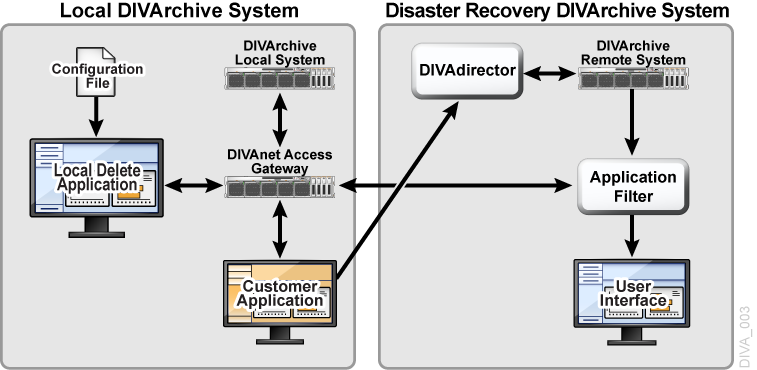1 System Overview
Oracle DIVArchive Local Delete is an application that monitors Oracle DIVAnet objects and deletes the objects locally after they have been replicated to a remote DIVArchive site.
Note:
The system tracks all instances of an object that exist on all sites and prevents you from deleting the last instance of an object.You can run Local Delete on demand using a batch file (see Running Local Delete Using the Batch File), or automatically as a Windows Service (see Installing or Uninstalling Local Delete as a Windows Service).
Local Delete operates in one of two modes:
ASAP Purge Mode (default)
ASAP Mode deletes local objects immediately after they are copied to another DIVArchive site. The ASAP configuration file (lynxLocalDelete.conf.ASAP.ini) is similar to the legacy Local Delete configuration file (see Appendix A for the default configuration file).
To configure ASAP Mode, see Configuring ASAP Purge Mode.
Delayed Purge Mode
Delayed mode deletes content based on the storage space of the disk and site verification criteria. Local Delete purges objects in the order in which they were archived to the local site.
Delayed mode uses the configuration file lynxLocalDelete.conf.delayed.ini (see Appendix B for a sample configuration file).
Note:
Delayed Purge Mode can only monitor a single DIVArchive disk array. To purge from multiple arrays, you must run multiple instances of Local Delete.To configure Delayed mode, see Configuring Delayed Purge Mode.
Setting the Watermark for Delayed Mode
You must set the high and low watermarks to specify how full the disk must be before Local Delete deletes content. When the DIVArchive array becomes x% full (x being the high watermark), object instances are deleted from the array until the disk reaches y% full (y being the low watermark).
See Site to Purge Configuration Parameters for more information on the watermark configuration file parameters.
Setting Site Verification Criteria for Delayed Mode
You can set verification criteria in the configuration file. The system only considers deleting an object if all of the criteria are true and the disk array has reached the high watermark. Since the utility deletes objects in the order in which they were archived, Local Delete might stop deleting (because it reaches the low watermark) before it deletes all objects that meet the criteria.
See Site Verification Criteria Configuration Parameters for more information on the site verification configuration file parameters.
Sample Local Delete Workflow
The sample Local Delete workflow in Figure 1-1 applies to both newly archived objects and previously archived objects.
